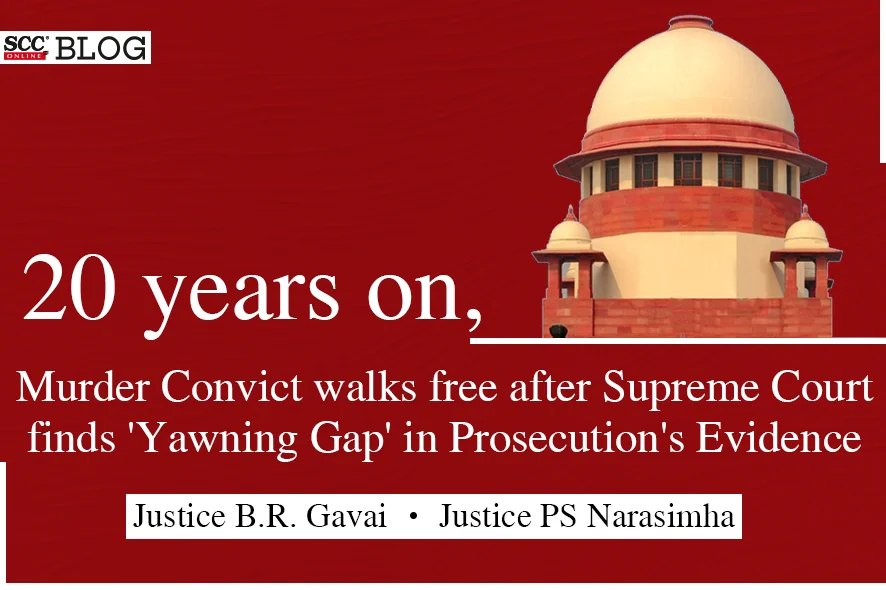Supreme Court: In a criminal appeal against Punjab and Haryana High Court’s Judgment, wherein, the convict’s appeal against conviction and life imprisonment for offence under Section 302 read with Section 34 of the Penal Code, 1860 (‘IPC’) was dismissed, the Division Bench of B.R. Gavai and PS Narasimha, JJ. allowed the appeal and acquitted the convict.
Factual Matrix
The complainant’s case was that the deceased received a phone call and left for the market and did not return to his home at night. The next day the complainant found the deceased’s body with his throat knotted with some cloth, and the right eye was badly injured. A prosecution witness, while travelling from Chandigarh, saw the accused persons carrying dandas and one of the boy’s clothes were stained with blood, being suspicious he noted the motorcycle’s number and informed the police about the same when he came to know of the death of the deceased. The accused persons had surrendered before the police on 17-04-2004 after making an extra-judicial confession before the former Sarpanch that one of the accused had borrowed money from the deceased and in the fear of getting insulted, when asked for repayment, he murdered the deceased with the help of other accused persons. The Trial Court rested its decision on the prosecution witnesses’ evidence and concluded the case based on circumstantial evidence. The High Court upheld the Trial Court’s decision and confirmed the conviction and life sentence.
Decision
The Court examined the former Sarpanch’s testimony and did not find it reliable, as his statement that he ‘never met deceased’ was contradictory to the complainant’s statement that deceased had met the former Sarpanch on 11-04-2004.
The Court also referred to a prosecution witness’s statement who was travelling from Chandigarh had seen the accused persons. The Court rejected his testimony as he had stated that he started from Chandigarh at 6 PM on 10-04-2004 (date of occurrence), however, the Court noted that the distance between Chandigarh and the place of occurrence is about 120 kilometers and takes about 2 hours to cover the distance even by car and there was no explanation as to how he took more than four hours to reach the scene of offence. The Court also noted that he said he was unaware and did not remember the name of the lodge where he stayed on the night of 09-04-2004. The Court said it was surprising that while engrossed in changing the wheel of his car at 10:30 PM, he noted the blood stains on one of the accused persons and recorded the motorcycle registration number, when there was nothing to indicate that he had a pen or a paper to readily note the registration number.
The Court also rejected another prosecution witness’s statement and noted that he saw the motorcycle from a distance when he went for an evening walk between 9:45 to 10:00 pm, in an area which does not have any streetlights. The Court said that the multi-tasking of urinating, coughing, seeing the motorcycle, noting the blood stains on clothes and recording the registration number was all simultaneous, and there is no evidence as to the way in which he had recorded the registration number, hence, making his statement highly improbable.
The Court also noted that instead of going to the police station, he reported the incident only on the 12-04-2004, that is two days later and instead of reporting the incident to the police chowki which is next to his residence, he went all the way to Sadar Police Station, Kaithal.
Regarding the weapon used in the crime, the Court noted that the post-mortem report stated that the incise wound was caused by a sharp-edged weapon and that no such weapon was seized by the police.
The Court said that there were no eyewitnesses, and the entire case of the prosecution depended upon circumstantial evidence.
Justice Gavai referred to Sharad Birdhichand Sarda v. State of Maharashtra, (1984) 4 SCC 116, wherein it was observed that “the circumstances from which the conclusion of guilt is to be drawn should be fully established and that the circumstances concerned “must or should” and not “may be” established.”
The Court stated that “there is a yawning gap between the charge against the appellant (convict) and the evidence that the prosecution has adduced.” The Court also stated that the circumstances did not establish the convict’s guilt. The Court reiterated that while the principle applicable to circumstantial evidence requires that the facts must be consistent with the hypothesis of the guilt of the accused. The Court said that in the present case the evidence adduced by the prosecution gave rise to doubts, improbabilities and inconsistencies.
Therefore, the Court viewed that the prosecution did not establish the case beyond reasonable doubt, hence acquitted the convict. Thus, the Court set aside the impugned Judgments.
[Pradeep Kumar v. State of Haryana, 2024 SCC OnLine SC 21, Decided on 05-01-2024]






